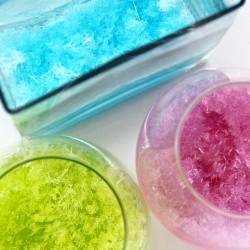I would like to encourage you to do science yourself and to do some nice and amazing experiments at home with your family. You can carry out all experiments with substances that you have at home and that can be found in every household during the Christmas season. Before we start, a word about safety: All experiments are harmless. Nevertheless, you should exercise caution and not leave children alone with it.
Oh yes, one more thing: in the Kitzbüheler Anzeiger, edition December 9th, 2016, four experiments were presented. As a special bonus you will find another one here .
Simply click on it to enlarge the pictures.
Have fun!
EXPERIMENT 1 – Fascinating lava lamp
What you need:
- white, 1 liter glass bottle
- ¼ liter of water
- ½ liter of oil, e.g. corn oil
- effervescent tablets
- liquid food coloring
Pour the water into the bottle. Add a few drops of food coloring to make it nice to look at (food coloring is not necessary for the experiment to work). Now slowly and carefully empty the oil. You will see the oil floating on the water. Wait until it’s clear again. Now break an effervescent tablet and drop the parts into the bottle. And you already have your own lava lamp.
An object swims in water if its density is less than that of water. One liquid also floats on top of the other if its density is lower. The density is the measure of the relationship between mass and volume. A block of styrofoam weighs much less than an equally large block of wood. Therefore, styrofoam has a significantly lower density. Oil behaves in exactly the same way to water. The density of the oil is less than that of the water, so it floats on top. Effervescent tablets fall to the bottom of the bottle. They contain substances that CO2, therefore carbon dioxide (correct: carbon dioxide). The CO2 rises and forms bubbles in the oil, which also take colored water with them. At the top is the CO2 released and the water sinks back again. You can repeat the experiment with new tablets several times.
Tip: It is particularly beautiful when you illuminate the bottle from below.
EXPERIMENT 2 – Hexed mandarin peels
What you need:
- easily compressible plastic bottle
- water
- a tangerine to be peeled
- a piece of mandarin peel
Fill the bottle to the brim with water. Please make sure that there is little or no air left in the bottle. Now stuff the piece of mandarin peel into it. Screw the bottle tight and wait a minute. Now squeeze the bottle (really) firmly and long. How bewitched the mandarin peel will sink to the bottom of the bottle. If you remove the pressure from the bottle, the bowl will rise again upwards. Fascinating, isn’t it?
(If it doesn’t work right away, wait a little longer or let a little more air into the bottle. Or maybe you are not pressing hard enough?)
The mandarin peel has a lower density than water, so it floats on top. If you look closely, you will see that there are countless bubbles in the bowl. They line up close together. There is a lot of air in these bubbles. Water has the special property that it cannot be compressed. If you now put strong pressure on the bottle, it will transfer to the mandarin peel. This strongly compresses the air bubbles. The mass of the mandarin peel remains the same, but due to the pressure it now takes up a smaller volume. As a result, their density rises above that of water and decreases. You can repeat the experiment until the bubbles have all burst; then the bowl will no longer rise.
Tip: eat the tangerine
EXPERIMENT 3 – Dancing Raisins
What you need:
- beautifully shriveled raisins
- Sparkling water
- a light drinking glass, jam jar or similar
Pour mineral water into the glass. Drop some raisins in it. Small bubbles quickly form on the raisins. After a short time, the raisins dance upwards, dancing. As soon as they have reached the water surface, they sink back down and the game starts again. Soon there will be a happy chaos of dancing raisins in the glass.
When grapes are allowed to dry to raisins, the water in the fruit evaporates through the skin. The skin remains intact. Now the raisin still has the same surface, but only a fraction of its volume as a grape. The skin needs space and therefore shrinks to a wasted, wrinkled cover. Unstable carbonic acid is contained in the mineral water. If you open the pressurized bottle, the carbonic acid immediately breaks down into CO2 and water. The carbon dioxide bubbles want to rise, but get caught in the folds of the raisins and take she with up. As soon as they reach the surface, they release the CO2 to the air and the raisins sink back down. Sometimes they don’t even reach the ground and are already snapped up and taken up with them on the way.
Tip: try different types of raisins. The experiment works best when the sparkling mineral water is completely fresh.
EXPERIMENT 4 – Leaping Flames
What you need:
- burning candle
- Lighter or matchstick
I wrote about it in the last blog article, from which a flame is built, how the burning works, and what chemical and physical processes take place in it. So it is a good idea to do a little experiment with a flame. Please be careful not to let children do the experiment on their own.
Blow out the candle. Ignite the match and move it one or two centimeters above the wick into the rising smoke. The flame will jump over the wick as if by magic and ignite it again.
As we in the last article learned, it is not the wick that burns in a flame, but vaporized candle wax. If you now blow out the flame, hot, invisible candle wax vapor rises for some time, which still has temperatures of up to 800 ° C and is therefore easy to ignite again. The flame follows the rising wax-steam flow downwards until it meets the wick, which immediately starts to burn again.
Tip: Measure the time how long you can ignite the wax-steam current after blowing out the candle.
EXPERIMENT 5 – Bizarre ice balls
What you need:
- liquid food coloring
- balloons
- water
- patience
Place a few drops of the food coloring in a balloon. Then fill the balloon with water. The best way to do this is to stretch the balloon by inflating it briefly and letting the air escape again. All of this, of course, before you let the food coloring drip into it. Fill the balloon so that it is about the size of your palm.
Now the water in the balloon has to freeze first. In winter just lay out on the terrace or balcony. If it is too warm, use the freezer. Now patience is required. Of course you can let the water in the balloon freeze properly. So you get beautiful, colorful ice cream balls, which are also suitable as garden decoration. But we don’t want the water to freeze completely. It should still be liquid inside.
Now it is time to carefully remove the stiff frozen balloon gum without destroying the ice. As a final step, carefully tap the colored ice cream ball and let the remaining water run out. Now look at the ice formation. We see bizarre ice figures and structures that have grown apparently chaotically.
The water freezes in from the outside, in the balloon from all sides at the same time. This is how an ice bowl first forms around the liquid interior. As long as the balloon rubber itself has not yet frozen stiffly, it can still stretch a little with the ice. With the increasing hypothermia of the water inside the balloon, ice threads, ice bars and ice filaments begin to form on the inside. They grow along small bumps and imperfections in the balloon rubber. Since the ice itself also grows irregularly, small peaks appear that quickly add new ice. This is how leaf-like structures are created. These structures can be recognized more easily by the food coloring.
Tip: Let a few balloon balls freeze completely. These filaments and ice sheets are also created here, but they are now in the surrounding ice. If you look at these ice balls against bright light, the structures shine through the clear ice. The structures bind the color of the food color better. – Now smash a ball with a hammer and look at the inside of the colored balls. There are photos of it in the gallery.
RELATED ITEMS
-

10 entertaining scientific experiments for children and adults
Children always try to learn something new every day and they always have a lot of questions. Some phenomena can be explained to them, but you can…
-
Christmas presents: tips for everything to give
Toddler Christmas is and remains a wonderful family celebration – but what would it be without gifts? We give tips and name strategies,…
-

11 Conventional tights christmas children, rana decoration
11 Conventional tights Christmas children – furnishing ideas are fun, but are not always trivial to implement. If you are in an apartment…
-

Every year the Germans celebrate Christmas. But long before the festival, the Christmas stress is dragging around gifts and roast Christmas…
















